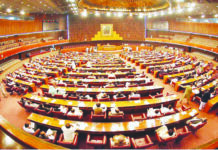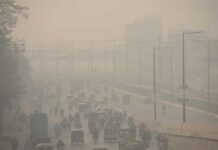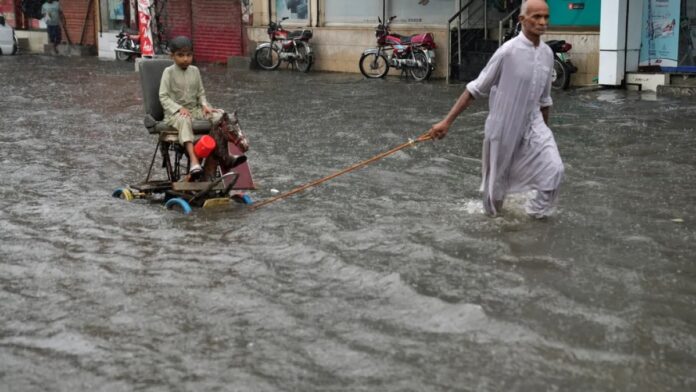ISLAMABAD: Pakistan is enduring one of its deadliest monsoon seasons, with heavy rainfall, flash floods, and landslides ravaging vast areas of the country.
Khyber Pakhtunkhwa (KP) remains the hardest-hit province, accounting for over 300 deaths. Remote districts like Buner and Swat have seen the worst devastation. The situation worsened on Monday when new rains intensified the already dire conditions across the region.
In Mardan, heavy downpours submerged parts of the city and its outskirts, while Nowshera experienced intense rainfall.
In Swabi, cloudbursts triggered flash floods and landslides, which led to the death of four people when their house collapsed. Two women and two children were killed, while seven others sustained injuries.
In Dalori village, flash floods submerged several houses, with landslides blocking roads to nearby settlements. These incidents underline the immense difficulty of reaching affected areas, which has hindered relief efforts.
The provincial capital, Peshawar, saw severe urban flooding, with streets in Saddar Bazaar, University Road, Gulbahar, and other areas submerged. Overflowing drains inundated key roads, paralyzing traffic and submerging vehicles, while houses near riverbanks were also affected.
In Punjab, cities like Multan, Kabirwala, Jhang, and Khushab were heavily impacted by the rains. In Chakwal, 67mm of rain was recorded in Choa Saidan Shah, with significant rainfall also measured in Wahali Zair, Kusk, and other areas. Bhakkar and Miani saw neighborhoods inundated, and agricultural land was damaged.
Flash floods also caused destruction in other parts of the country. In Kurram, a flood swept through Parachinar, damaging roads and embankments, although no casualties were reported. However, the situation worsened in Balochistan, where rainfall had a devastating effect, leaving behind damaged infrastructure and hampering relief efforts.
Rivers across the country are under immense pressure, with the Indus River experiencing medium flood levels at Kalabagh, Jinnah Barrage, and Chashma Barrage. Evacuation orders have been issued for settlements along these rivers, and authorities are on high alert. The rising water levels have prompted concerns that more severe flooding is imminent.
At Tarbela and Mangla dams, water levels are rapidly rising, with Tarbela nearing full capacity at 97%, and Mangla at 71%. The continued rainfall, combined with glacier melt, is contributing to the rising water levels, further heightening the flood risk. As the monsoon season continues, authorities are working to prevent any further damage.
The Pakistan Meteorological Department (PMD) has warned that heavy rain and thunderstorms are expected to continue until August 19, with additional wet spells likely after August 22. Areas at the highest risk include Charsadda, Nowshera, Mardan, Swabi, and various parts of Khyber Pakhtunkhwa.
The flood situation is worsening, and the government has called for more coordinated relief efforts.
The NDMA, in collaboration with the federal and provincial governments, is dispatching relief goods and personnel to affected regions. The relief efforts include the provision of food rations, medical supplies, tents, and blankets. The NDMA is working with local disaster management authorities and the armed forces to ensure that help reaches the flood victims as quickly as possible.
Federal Minister for Information and Broadcasting, Attaullah Tarar, emphasized that the federal government was doing everything in its power to coordinate relief activities. He stated that Prime Minister Shehbaz Sharif has instructed the NDMA to remain in close contact with the provincial authorities for better coordination and faster response.
In terms of infrastructure, the floods have damaged roads, bridges, and homes, particularly in areas near riverbanks. The floods also damaged irrigation systems, exacerbating the challenges faced by local farmers. In Swat, Mingora, and Malakand, intense rains disrupted daily life, while the town of Buner faced major challenges due to blocked roads and cut-off settlements.
The NDMA has continued to issue flood warnings and urge citizens to remain cautious, especially in high-risk areas. The monsoon rains, though essential for Pakistan’s agriculture, have wreaked havoc in various parts of the country, prompting questions about the sustainability of current disaster management systems and the need for climate adaptation strategies.
As this year’s monsoon season intensifies, experts warn that climate change is exacerbating the severity of these events, contributing to higher rainfall, flash floods, and the increased vulnerability of communities living in flood-prone areas. Pakistan, one of the world’s most climate-vulnerable countries, continues to face the impacts of extreme weather patterns, which are expected to worsen in the years ahead.























